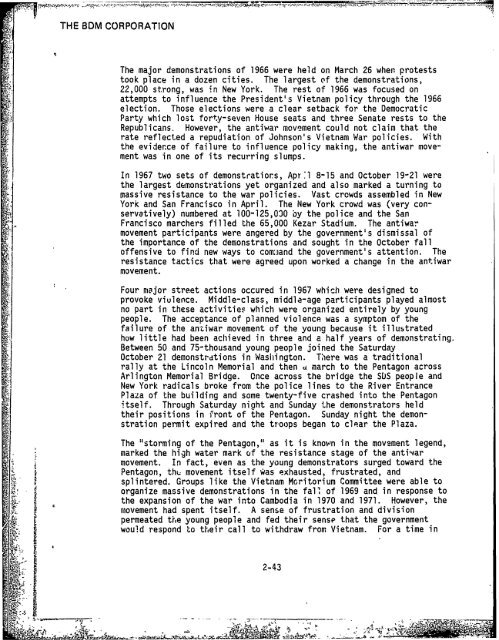policy - The Black Vault
policy - The Black Vault
policy - The Black Vault
You also want an ePaper? Increase the reach of your titles
YUMPU automatically turns print PDFs into web optimized ePapers that Google loves.
THE BDM CORPORATION<br />
<strong>The</strong> major demonstrations of 1966 were held on March 26 when protests<br />
took place in a dozen cities. <strong>The</strong> largest of the demonstrations,<br />
22,000 strong, was in New York. <strong>The</strong> rest of 1966 was focused on<br />
attempts to influence the President's Vietnam <strong>policy</strong> through the 1966<br />
election. Those elections were a clear setback for the Democratic<br />
Party which lost forty-seven House seats and three Senate rests to the<br />
Republicans. However, the antiwar movement could not claim that the<br />
rate reflected a repudiation of Johnson's Vietnam War policies. With<br />
the evidence of failure to influence <strong>policy</strong> making, the antiwar movement<br />
was in one of its recurring slumps.<br />
In 1967 two sets of demonstrations, April 8-15 and October 19-21 were<br />
the largest demonstrations yet organized and also marked a turning to<br />
massive resistance to the war policies. Vast crowds assembled in New<br />
York and San Francisco in April. <strong>The</strong> New York crowd was (very conservatively)<br />
numbered at 100-125,030 by the police and the San<br />
Francisco marchers filled the 65,000 Kezar Stadium. <strong>The</strong> antiwar<br />
movement participants were angered by the government's dismissal of<br />
the importance of the demonstrations and sought in the October fall<br />
offensive to find new ways to com::iand the government's attention. <strong>The</strong><br />
resistance tactics that were agreed upon worked a change in the antiwar<br />
movement.<br />
Four major street actions occured in 1967 which were designed to<br />
provoke viulence. Middle-class, middle-age participants played almost<br />
no part in these activities which were organized entirely by young<br />
people. <strong>The</strong> acceptance of planned violence was a symptom of the<br />
failure of the antiwar movement of the young because it illustrated<br />
how little had been achieved in three and a half years of demonstrating.<br />
Between 50 and 75-thousand young people joined the Saturday<br />
October 21 demonstrdtions in Washington. <strong>The</strong>re was a traditional<br />
rally at the Lincoln Memorial and then a march to the Pentagon across<br />
Arlington Memorial Bridge. Once across the bridge the SUS people and<br />
New York radicals broke from the police lines to the River Entrance<br />
Plaza of the building and some twenty-five crashed into the Pentagon<br />
itself. Through Saturday night and Sunday the demonstrators held<br />
their positions in front of the Pentagon. Sunday night the demonstration<br />
permit expired and the troops began to clear the Plaza.<br />
<strong>The</strong> "storming of the Pentagon," as it is known in the movement legend,<br />
marked the high water mark of the resistance stage of the antiwvar<br />
movement. In fact, even as the young demonstrators surged toward the<br />
Pentagon, thu movement itself was exhausted, frustrated, and<br />
splintered. Groups like the Vietnam Moritorium Committee were able to<br />
organize massive demonstrations in the fall of 1969 and in response to<br />
the expansion of the war into Cambodia in 1970 and 1971. However, the<br />
movement had spent itself. A sense of frustration and division<br />
permeated the young people and fed their sense that the government<br />
would respond to their call to withdraw from Vietnam. For a time in<br />
Lzc 54_<br />
Q 1--A<br />
.7ý<br />
2-43
















